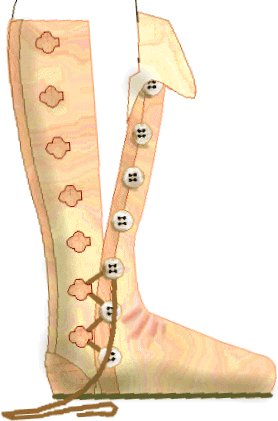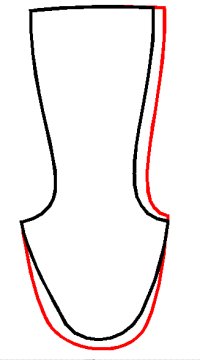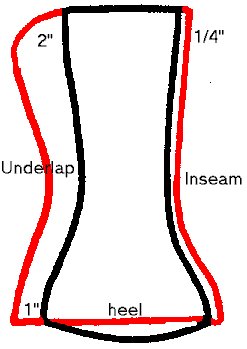
|
Pattern Adjustments...Among other thingsWARNING: Don't start cutting leather until you have read this section and the next through at least once. You can re-do markings, but you can't 'un-cut' something. We need to modify the patterns a bit more, adding seam allowances and adjusting for fit, then make patterns for the heel block, foxing, lace foxing, lacing blocks, and sole. Stay with me, because this can get a little confusing - especially keeping track of what's inside the leg, what's outside. The front is especially troublesome because it appears symmetrical. Make good notes! |
| Now, we need some other pattern pieces. The first is the heel block. It adds stiffness to the heel of the boot, keeping it from curling under the subject's heel. It also provides the first lacing block. If it looks a little odd, bear in mind that the part that sticks out will be folded under to form a loop through which the lace will be passed. Also, add 1/4" to 1/2" to the sole edge. Click here for a pattern (PDF format.) |
|

|
The sole is probably the easiest piece to do. add 1/4" to 1/2" all the way around. However, make sure you keep the original piece: you're going to need both, one with the extra and one without. |
I've done the Fleur de Lis once. Once. Never again. You have to stitch each of the roundels down, and even by machine (or maybe especially by machine) it sucked. The rough style is an idea I got from a friend of mine named Fox. The rough edge is left on top and you stitch it down as if it were round, letting the rough edge do as it will. Don't forget: even though I only have it illustrated on the Fleur de Lis, you must add the extra piece that will fold under and provide the loop to lace through (like the example on the bottom right).
1 When you see the references 'add 1/4" to 1/2"', it pretty much up to you which one you do. 1/2" is easier to work with, but it leaves more seam allowance inside the boot. 1/4" will feel better on the feet, but it's easy then to get too close the edge when you're sewing and run off. Up to you, just make sure that you do the same on every edge that comes in contact wtih the sole, and the sole itself.




